This series features cats in art. Cats have been depicted in paintings and drawings by both unknown and famous artists throughout time. This series begins in 1400 BC through to 1997 AD.
For earlier works see parts 1 - 4.
This is part 5 of 5-part series on Cats in Art:
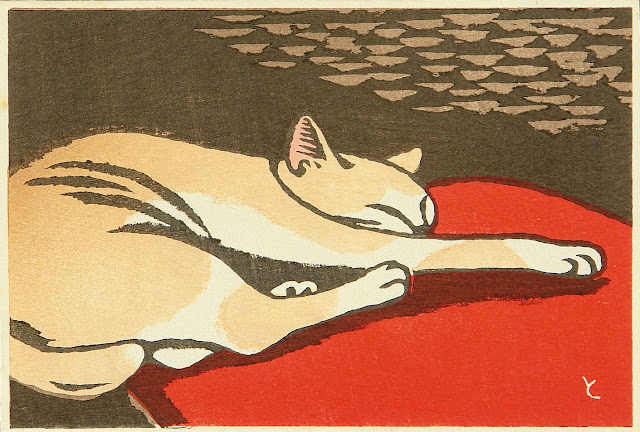 |
| c1930s Cat by Tomoo Inagaki (1902-1980) colour woodblock print |
Tomoo Inagaki (aka Inagaki Tomoo) was born in 1902 in Tokyo. As a high school student and later as an employee of a steel company he dabbled as a self-taught artist in oil painting and in printmaking. Koshiro Onchi had published an art magazine about poetry and prints, called Poems and Hanga. The young Tomoo Inagaki was impressed by the modern prints published in this magazine - many by Koshiro Onchi and Unichi Hiratsuka. It gave him the last kick to make a decision for an artistic career. He quit his job at the steel company and attended a commercial art class for two years.As a graduate of a commercial high school,
Inagaki had a natural sense for the financial aspects of life. He decided to go into commercial arts instead of becoming a fine but starving artist. He soon established his own commercial art studio in Tokyo.
Inagaki could make a living with his commercial design studio. This enabled him to continue to work as a print maker. But World War II put an end to his design studio. He died in 1980 in Tokyo.
 |
| 1931 Cat and Tomato Plant by Takahashi Shotei (1871-1945) woodblock print, colour and ink on paper 35.3 x 53.1 cm (sheet) The Museum of Fine Arts, Houston |
Hiroaki Takahashi was born in Tokyo in 1871. As a young artist he was given the artistic name Shotei by his uncle, Matsumoto Fuko, under whose tutelage he was apprenticing. When he was 16 years old, he started a job with the Imperial Household Department of Foreign Affairs, where he copied the designs of foreign ceremonial objects. As with many Japanese woodblock artists over his lifetime he signed his work with various names and worked for several publishing companies.
After studying art, Shotei and Terazaki Kogyo founded the Japan Youth Painting Society in 1889. In 1907, as a successful artist, he was recruited by Shozaburo Watnabe to contribute to the Shin Hanga ("New Prints") art movement in Japan.
Watanabe helped to fulfil the Western demand for Ukiyoe woodblock prints which would be similar to familiar historical masters of that genre, including Hiroshige. In about 1921 Shotei added the artistic name of Hiroaki. In 1923 the Great Kanto earthquake (and subsequent fire) destroyed Watanabe's facilities; this included all Shin Hanga woodblocks. Thus, Shotei recreated prior designs destroyed in the Great Kanto earthquake and also continued to produce new woodblocks. Shotei died of pneumonia on February 11, 1945. There is a persistent rumour that he died in the atomic bombing of Hiroshima, but this is incorrect. His works are held in the permanent collections of many museums worldwide.
 |
| 1932 Blue Cat by Louis Wain |
 |
| 1936 Cat & I by Gertrude Abercrombie (1909-1977) woodcut on paper 14.3 x 15.7 cm National Portrait Gallery Collection, Smithsonian |
Gertrude Abercrombie, born 1909 in Austin, Texas, was an American painter based in Chicago. Called "the queen of the bohemian artists", Abercrombie was involved in the Chicago jazz scene and was friends with musicians such as Dizzy Gillespie. Charlie Parker, and Sarah Vaughan, whose music inspired her own creative work. After studying figure drawing briefly at the Art Institute of Chicago, she took a year-long course in commercial art at the American Academy of Art in Chicago, leading to her first job drawing gloves for Mesirow Department Store advertisements. She also worked briefly as an artist for Sears.
From 1934 to 1940 she served as a painter for the WPA (Works Progress Administration, and in 1934 the Chicago Society of Artists held a solo show of her work. During the 1930s and 1940s she also began creating woodcuts.
 |
| before 1939 Carol Singing Cats by Louis Wain (1860-1939) |
 |
| before 1939 Portrait of a Lady with her Cat by Boris Grigoriev (1886-1939) oil on canvas 81 x 65.5 cm Private Collection |
Boris Grigoriev was born in Rybinsk and studied at the Stroganov Art School from 1903 to 1907. Grigoriev went on to study at the Imperial Academy of Arts in St. Petersburg under from 1907 to 1912. He began exhibiting his work in 1909 as a member of the Union of Impressionists group, and became a member of the World of Art movement in 1913.
After his return to Saint Petersburg in 1913 he became part of the Bohemian scene in there. From 1916 to 1918 he created a series of paintings and graphic works, Russia, depicting the poverty and strength of rural Russia.
in 1919, Grigoriev travelled and lived abroad in many countries including Finland, Germany, France, the United States, Central and South Americas. Grigoriev lived for a time in Paris, where he attended the Académie de la Grande Chaumière. In Paris he was strongly influenced by Paul Cézanne. Grigoriev died in Cagnes-sur-Mer in 1939.
 |
| before 1939 Russian Blue Cat by Louis Wain (1860-1939) |
 |
| 1939 Cat Catching a Bird by Pablo Picasso (1881-1973) oil on canvas 81 x 100 cm Musée Picasso, Paris |
Pablo Picasso was one of the most influential artists of the 20th century. Born in 1881 in Málaga, Spain, his prodigious talent was cultivated early on by his father the painter Jose Ruíz Blasco. Picasso went on to attend the Royal Academy of San Fernando in Madrid, and lived for a time in Barcelona before settling in Paris in 1904. Immersed in the avant-garde circles of Gertrude Stein, he rapidly transitioned from Neo-Impressionism through the Blue Period and Rose Period, before reaching a culmination in his masterpiece Les Demoiselles d’Avignon (1907).
Constantly in search of pictorial solutions and in dialogue with his friend Georges Braque, Picasso melded forms he saw in African sculpture with the multiple perspectives he gleaned from Paul Cézanne, to produce Cubism. Not limited to painting, the artist also expressed himself through collage, sculpture, and ceramics. Having been deeply affected by the ongoing Spanish Civil War, Picasso created what is arguably his most overtly political work Guernica (1937), a mural-sized painting depicting carnage with jagged shapes and contrasting grayscale. The artist was prolific up until his death on April 8, 1973 in Mougins, France. Today, his works are held in the collections of The Museum of Modern Art in New York, the Tate Gallery in London, the Hermitage Museum in St. Petersburg, as well as institutions devoted solely to his life work, such as the Museo Picasso Málaga, the Museu Picasso in Barcelona, and the Musée National Picasso in Paris.
 |
| 1939 Cat devouring a Bird by Pablo Picasso (1881-1973) oil on canvas 97 x 129 cm Victor W. Ganz Collection, New York |
 |
| c1940-50 Black Cat by Tomoo Inagaki (1902-1980) colour woodblock print |
 |
| 1941 Mother Cat with Kittens by Morris Hirshfield (1872–1946) oil on canvas 61 x 91.4 cm American Folk Art Museum, New York City |
Morris Hirshfield was a Polish-American painter. He "is considered one of the most critically acclaimed self-taught artists of the 20th century" according to the J. Paul Getty Museum. Hirshfield was born in Poland, but emigrated to the United States at the age of eighteen. After various jobs Hirshfield began to paint in 1937. He was soon championed by gallerist Sidney Janis who had a great interest in self-taught artists. Janis included some of Hirshfield's works in a 1939 exhibition, Contemporary Unknown American Painters, and a 1942 book, They Taught Themselves: American Primitive Painters of the 20th Century. His painting found favour in surrealist circles; he was lauded by Andre Breton, and was a participant in the first American surrealist exhibition, First Papers of Surrealism, in 1942.
He received a one-man show at the Museum of Modern Art in 1943. The show occasioned some negative criticism; Art Digest referred to Hirshfield as "The Master of Two Left Feet”, and the bad press the show received figured into the demotion of MoMA's director, Alfred H. Barr Jr. Hirschfield died in New York City in 1946.
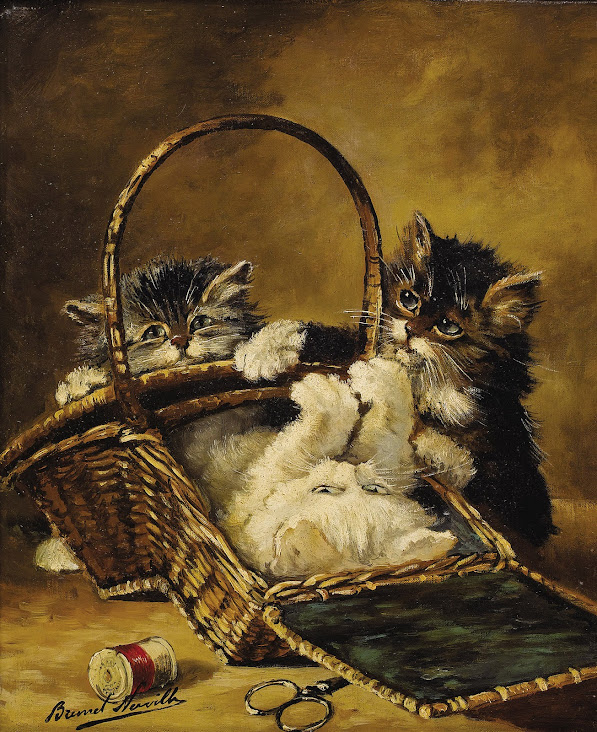 |
| before 1942 Kittens in a Sewing Basket by Alfred-Arthur Brunel de Neuville (1851-1942) |
Alfred-Arthur Brunel de Neuville was a French painter known mainly for paintings of still life and animals, especially cats. By his twenties he had become a well-known animal and still-life artist, and remained popular throughout his life. Following in the footsteps of Henriëtte Ronner-Knip and other C19th artists. His paintings exuded a sentimental realist style. His works are in museums at Béziers, Brest, Chateau Thierry, and Louviers. He died in 1941 and is buried in Montmartre Cemetery in Paris.
 |
| before 1945 Tabby Cat by Benson B. Moore (1882-1974) etching and drypoint 17.5 x 22.2 cm Smithsonian American Art Museum |
Benson Bond Moore was born in 1882 in Washington, D.C. He learned the conservation of paintings from his father, studied at the Corcoran School of Art with Edmund Clarence Messer and Richard Norris Brooke, and also with Max Weyl. He then tudied drawing at the Linthicum Institute under Ballenger. Moore illustrated many books and articles for the Star with etchings and engravings. He taught etching at the Hill School of Art, and settled in Florida in 1942. Moore died 1974 in Stuart, Florida.
 |
| 1947 Girl with a Kitten by Lucien Freud (1922-2011) oil on canvas 39.5 x 29.5 cm Private Collection |
Lucien Freud was born in Berlin in 1922, German-born British painter, draughtsman, and etcher, a grandson of Sigmund Freud. He moved to England with his parents in 1933, and acquired British nationality in 1939. His earliest love was drawing, and he began to work full time as an artist after being invalided out of the Merchant Navy in 1942. In 1951 his Interior at Paddington (Walker AG, Liverpool) won a prize at the Festival of Britain, and after this he built up a formidable reputation as one of the most powerful contemporary figurative painters.
Portraits and nudes were his specialities, often observed in arresting close-up. He preferred to paint people he knew well: ‘If you don't know them, it can only be like a travel book.
’His early work was meticulously detailed, so he has sometimes been described as a Realist, but the subjectivity and intensity of his work has always set him apart from the sober tradition characteristic of most British figurative art since the Second World War. In his later work (from the late 1950s) his handling became much broader. He was also an outstanding etcher. In 1993 Peter Blake wrote that since the death of Francis Bacon the previous year, Freud was ‘certainly the best living British painter’ and by this time he was also well known abroad. His fame has been won in spite of an aversion to self-publicity. Lucien Freud died in London in July, 2011.
 |
| 1950-51 Two Cats by Will Barnet (1911-2012) ink on paper 48.9 x 34.1 cm Cooper Hewitt, Smithsonian Design Museum |
Barnet's (American, 1911 - 2012) professional career spanned nearly nine decades, from his early work in the Graphic Arts Division of the Federal Art Project of the Works Progress Administration to recent retrospective exhibitions. His work appears in more than 200 museum collections, including the MFA Boston, the MoMA in New York, the Guggenheim in New York, the Vatican Museum in Rome, and the British Museum in London. Barnet went on to teach at many institutions, including Cooper Union and Yale University. He was a member of the National Academy of Design and the American Academy of Arts and Letters, as well as a fellow of the Royal Society of Arts in London. In 2011, Barnet received the National Medal of Arts from President Obama in Washington DC.
 |
| 1950-75 Geef een boek (Give a book) Dutch poster |
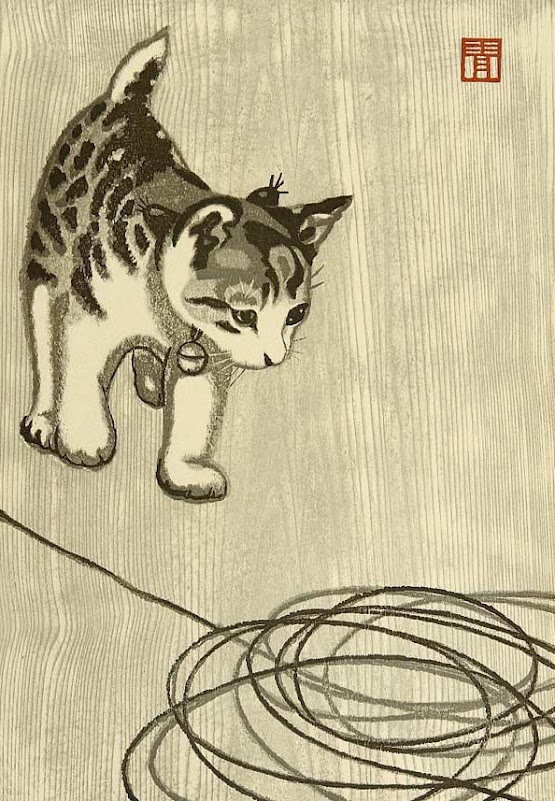 |
| 1950s-60s Kitten and Wool by Masaharu Aoyama (1893-1969) woodblock print 45 x 31 cm (sheet) |
Masaharu Aoyama attended Tokyo School of Fine Arts. A student of ink painting, Aoyama worked in the Imperial Household Museum until 1939. As a printmaker, Aoyama belonged to the Sosaku Hanga movement, producing self-carved woodblocks prints. While he self-printed some of these works, others were printed in Ishiyama’s publishing house. He presented these prints in the 1936 Teiten and Nihon Sosaku Hanga Kyokai exhibitions. In the 1950s, Aoyama focused on images of seagulls flying over water. His prints may be signed “Seiji” (Aoyama is also known as Aoyama Seiji) and sealed “Ao.”
 |
| 1951 The Cat by Alberto Giacometti (1901-1966) bronze 32 x 83 x 13 cm In 2018 The Cat sold at auction for £12.6 million |
Alberto Giacometti was a Swiss sculptor, painter, draftsman and printmaker. Beginning in 1922, he lived and worked mainly in Paris but regularly visited his hometown Borgonovo to see his family and work on his art. He was one of the most important sculptors of the 20th century. His work was particularly influenced by artistic styles such as Cubism and Surrealism. Around 1935 he gave up on his Surrealist influences in order to pursue a more deepened analysis of figurative compositions.
Between 1938 and 1944 Giacometti's sculptures had a maximum height of seven centimeters. Their small size reflected the actual distance between the artist's position and his model. In this context he self-critically stated: "But wanting to create from memory what I had seen, to my terror the sculptures became smaller and smaller.” After World War II. Giacometti created his most famous sculptures: his extremely tall and slender figurines. In Giacometti's whole body of work, his painting constitutes only a small part. After 1957, however, his figurative paintings were equally as present as his sculptures. The almost monochrome paintings of his late work do not refer to any other artistic styles of modernity. Giacometti died in 1966.
 |
| 1854 Cats Named Sam IV lithograph 22 x 15 cm |
 |
| 1954 Cats Named Sam IV 51 lithograph 23 x 14 cm |
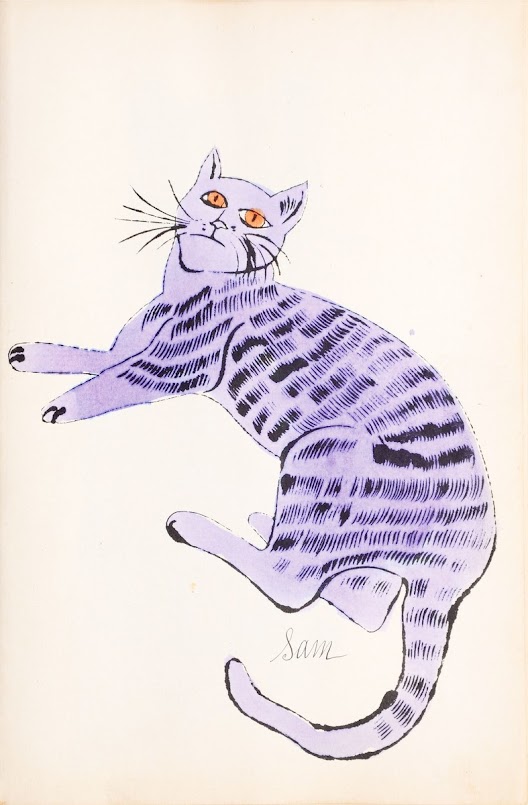 |
| 1954 Cats Named Sam IV 52 lithograph 23 x 15 cm |
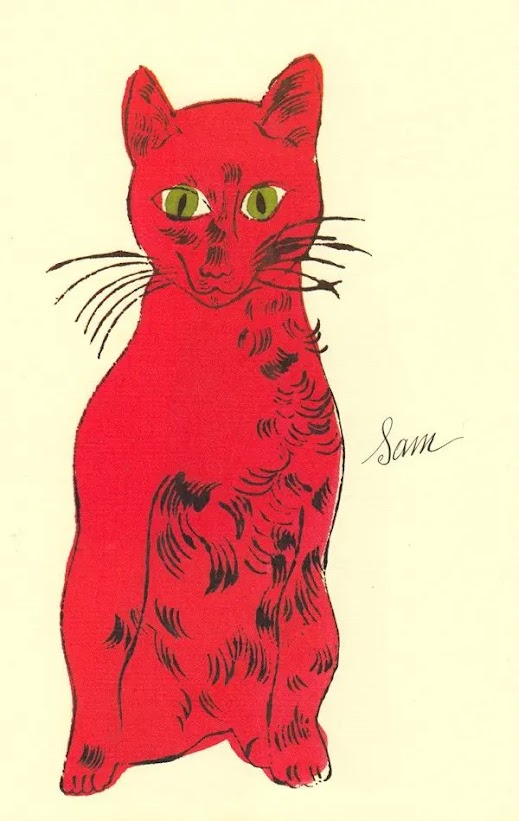 |
| 1954 Cats Named Sam IV 53 lithograph 23 x 15 cm |
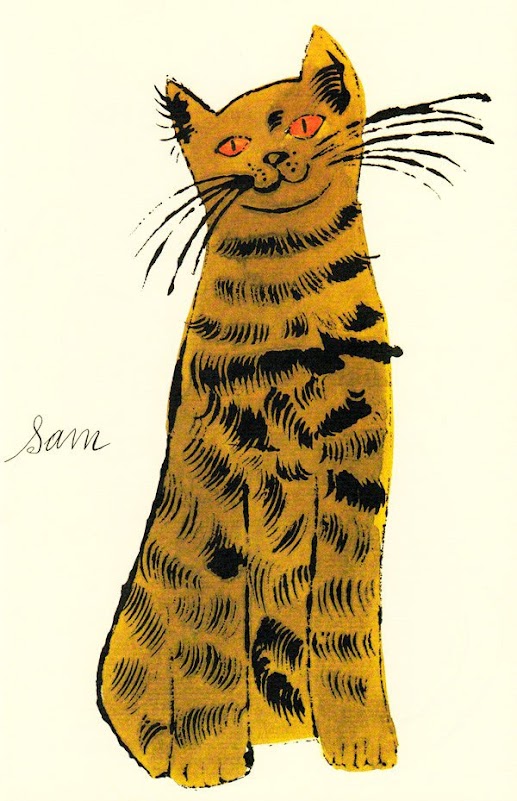 |
| 1954 Cats Named Sam IV 54 lithograph 23 x 15 cm |
 |
| 1954 Cats Named Sam IV 56 lithograph 23 x 15 cm |
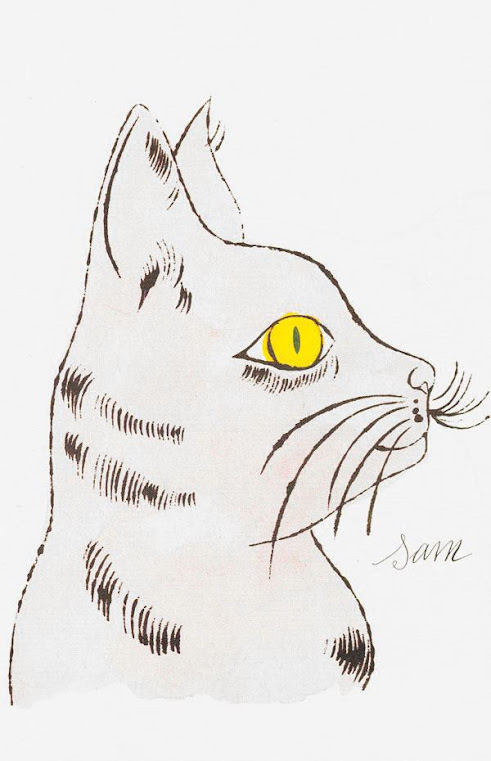 |
| 1954 Cats Named Sam IV 57 lithograph 23 x 15 cm |
 |
| 1954 Cats Named Sam IV 58 lithograph 23 x 15 cm |
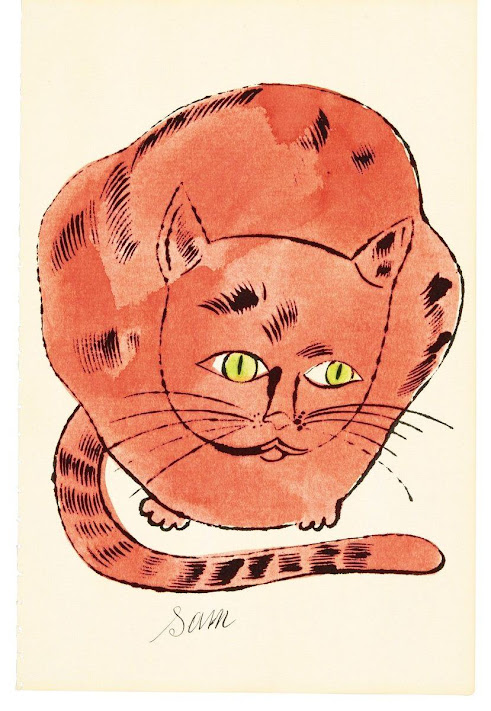 |
| 1954 Cats Named Sam IV 59 lithograph 23 x 15 cm |
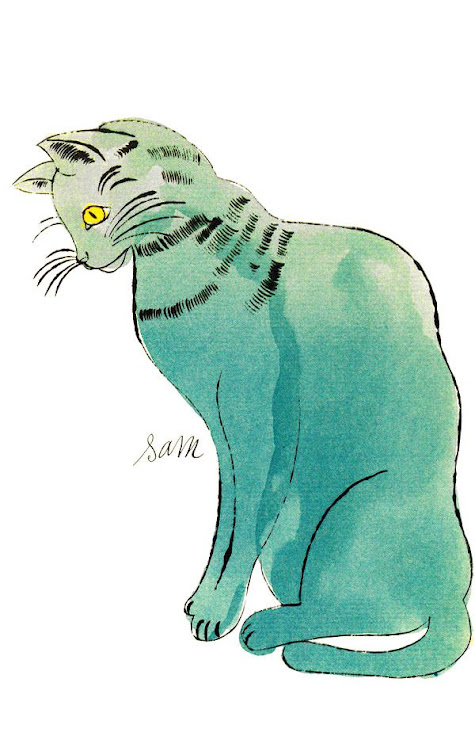 |
| 1954 Cats Named Sam IV 60 lithograph 23 x 15 cm |
 |
| 1954 Cats Named Sam IV 61 lithograph 22 x 15 cm |
 |
| 1954 Cats Named Sam IV 61 lithograph 22 x 15 cm |
 |
| 1954 Cats Named Sam IV 68 lithograph 22 x 14 cm |
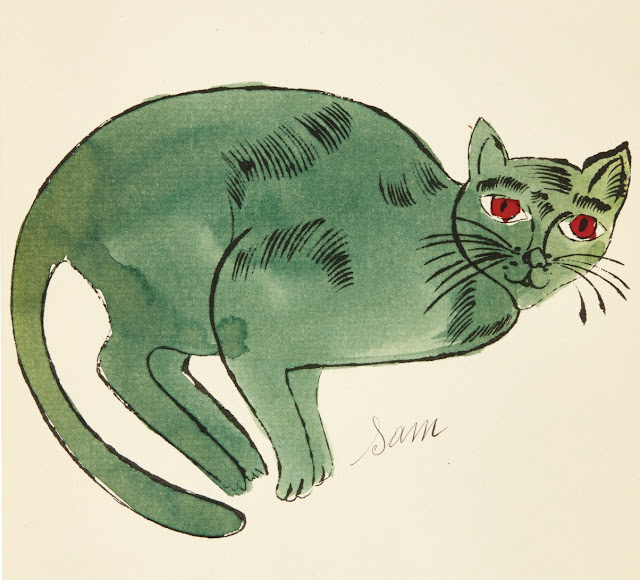 |
| 1954 Cats Named Sam IV 67 lithograph 23 x 15 cm 2 |
 |
| 1954 Cats Named Sam IV 67 lithograph 23 x 15 cm |
 |
| 1954 Cats Named Sam IV 66 lithograph 23 x 15 cm |
 |
| 1954 Cats Named Sam IV 65 lithograph 22 x 15 cm |
 |
| 1954 Cats Named Sam IV 64 lithograph 23 x 15 cm |
Andy Warhol ( born Andrew Warhola Jr. in Pittsburgh) was an American artist, film director, and producer who was a leading figure in Pop Art. His works explore the relationship between artistic expression, advertising, and celebrity culture that flourished by the 1960s, and span a variety of media, including painting, silkscreening, photography, film, and sculpture.
He initially pursued a successful career as a commercial illustrator. After exhibiting his work in several galleries in the late 1950s, he began to receive recognition as an influential and controversial artist. His New York studio, “The Factory,” became a well-known gathering place that brought together distinguished intellectuals, drag queens, playwrights, Bohemian street people, Hollywood celebrities, and wealthy patrons. He promoted a collection of personalities known as Warhol superstars, and is credited with inspiring the widely used expression "15 minutes of fame". In the late 1960s he managed and produced the experimental rock band The Velvet Underground and founded Interview magazine. He authored numerous books, including The Philosophy of Andy Warhol and Popism: The Warhol Sixties. After gallbladder surgery, Warhol died in February 1987 at the age of 58 in New York.
Note: Posts on the works of Andy Warhol can be found in the index of this blog.
 |
| 1965 Untitled (Cat) by Lawrence Lebduska (1894-1966) oil on paperboard 36.5 x 21.6 cm Smithsonian American Art Museum |
Lawrence Lebduska was born in Baltimore, Maryland, and as a young boy moved with his parents to their native Bohemia (now part of the Czech Republic). He went to school to be a stained-glass maker, like his father, and later studied with noted set designer Josef Svoboda. Lebduska returned to the United States when he was eighteen and settled in New York. He painted murals across the city and worked for the Works Progress Administration during the Great Depression. Lebduska loved nature, and his paintings focused on animals — his favourite were horses. He placed his menagerie in bright landscapes, which often combined disparate scenes like the forest and jungle. Lebduska experienced great success in the late 1930s and early 1940s when there was a new interest in self-taught artists, but his popularity later waned and his work was largely forgotten. He was known to trade his paintings for beer and cigarettes, until his work regained popularity with a one-man show in New York six years before his death.
 |
| 1963 Stetching Cat by Tomoo Inagaki (1902-1980) colour woodblock print |
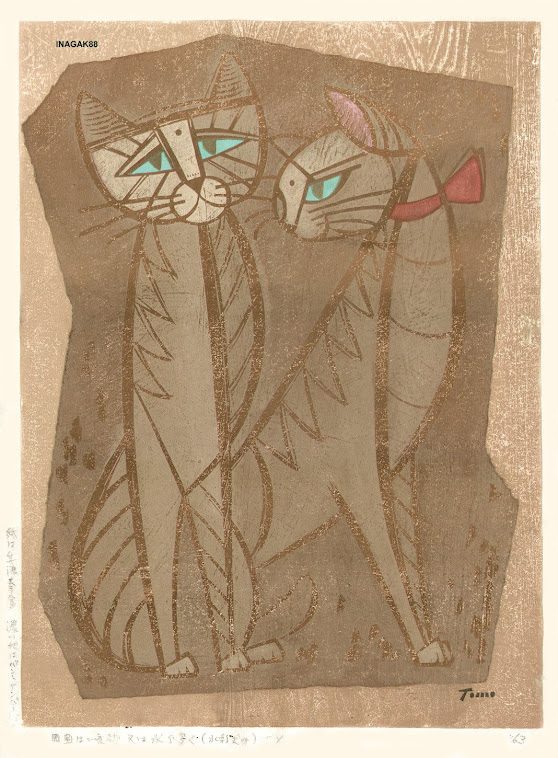 |
| 1963 Seduction of Cat byTomoo Inagaki (1902-1980) colour woodblock print |
 |
| 1962 Woman and Cats by Will Barnet (1911-2012) colour woodcut on paper 58.1 x 62.2 cm Smithsonian American Art Museum |
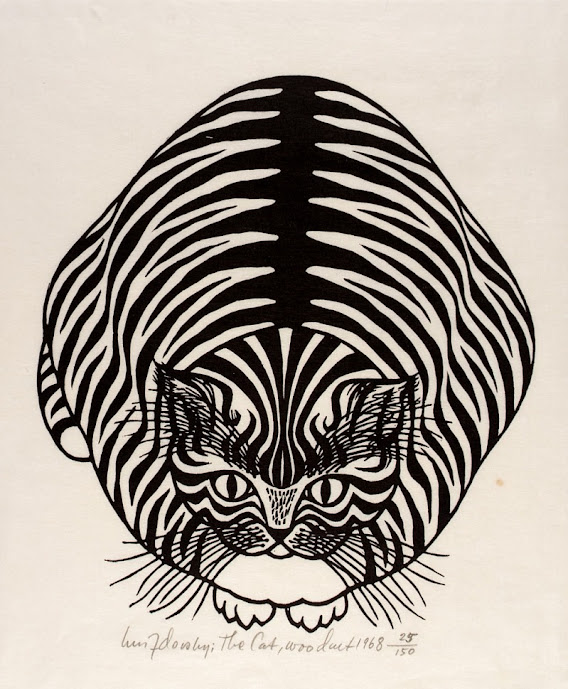 |
| 1962 The Cat by Jacques Hnizdovsky (1915-1985) woodcut on paper 26.9 x 24.1 cm Smithsonian American Art Museum |
Jacques Hnizdovsky was born in Ukraine in 1915 and he studied art in Warsaw and Zagreb. Soon after he moved to the United States in 1949, A. Hyatt Mayor of the Metropolitan Museum chose his woodcut Bush for a Purchase Award at the 1950 Minneapolis Institute of Art print exhibition. That was a key moment encouraging the artist to abandon other work and become a full-time artist.
Between 1950 and his death in 1985 the artist produced more than 375 prints, primarily woodcuts and linocuts, as well as several fine etchings. His graphic work is always distinctively his own, even though he openly drew influences from his love of Durer, Japanese prints and the folk art designs of his native Borshchiv.
Hnizdovsky’s work was exhibited at many one-man shows throughout the U.S., including shows at Associated American Artists in 1971 and 1979. His works have also been in major foreign exhibitions- in the USSR in 1963, Japan in 1967, Italy in 1972, Canada in 1983 and 1985 and Ukraine in 1990.
 |
| 1962 Still Life with Cat and Lobster by Pablo Picasso (1881-1973) oil on canvas 130 x 162 cm Private Collection |
 |
| 1962 Cat Making Up by Tomoo Inagaki (1902-1980) colour woodblock print 63.7 x 46.3 cm Art Institute of Chicago, IL |
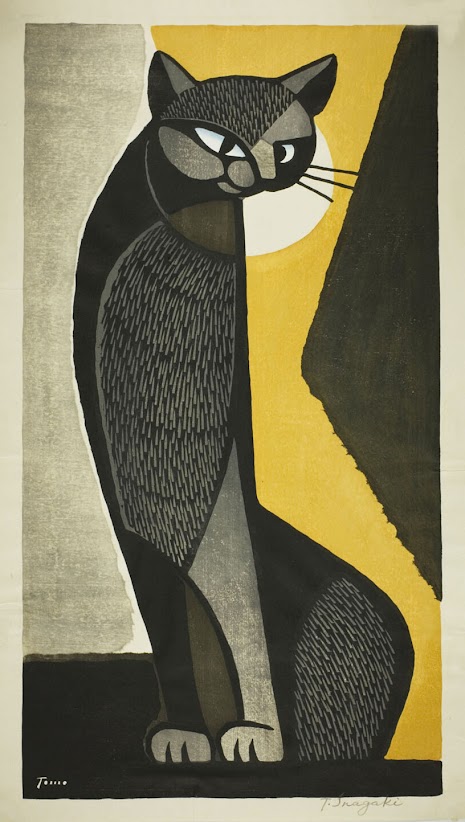 |
| c1960 Black Cat by Tomoo Inagaki (1902-1980) colour woodblock print 57.5 x 33 cm Art Institute og Chicago, IL |
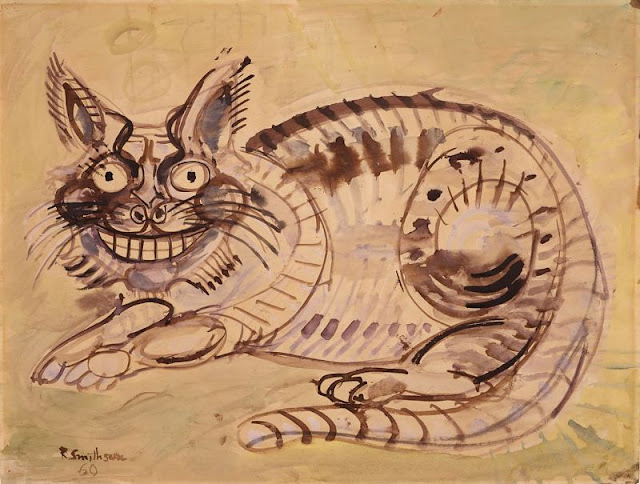 |
| 1960 Untitled (Cat) by Robert Smithson (1938-1973) watercolour on paper 44.4 x 59.7 cm Hirshhorn Museum and Sculpture Garden |
Robert Smithson was a seminal American artist and writer known for pioneering the Land Art movement. His monumental earthen sculptures such as Spiral Jetty (1970), were inspired by the Minimalist work of his contemporaries, as well as geology, science fiction, and the concept of entropy. Born in 1938 in Passaic, NJ, he briefly studied at the Art Students League in New York, where he began producing collages and paintings in the style of the Abstract Expressionists David Smith and Jackson Pollock.
During the early 1960s, Smithson was introduced to Carl Andre, Donald Judd, Claes Oldenburg, and his future wife Nancy Holt; their combined influence led him to pursue a significantly different art practice. Through the 1960s, Smithson produced works which employed both industrial and organic materials. In July 1973, Having completed Spiral Jetty, Smithson embarked on a new earthwork project. Tragically, while surveying the new project site from the sky, his plane crashed, killing Smithson, the pilot, and his photographer. Today, the artist’s works are held in the Dia:Beacon in New York, the National Gallery of Art in Washington, D.C., the Walker Art Centre in Minneapolis, and the National Gallery of Australia in Canberra, among others.
 |
| 1956 Chatting Cats by Tomoo Inagaki (1902-1980) colour woodblock print |
 |
| 1966 Cat Mobile by Alexander Calder (1898-1976) painted sheet metal and steel wire 50.8 x 66 x 66 cm Collection Museum of Contemporary Art, Chicago |
Alexander Calder was born in 1898, in Lawnton, Pennsylvania. In 1919, he received an engineering degree from Stevens Institute of Technology, Hoboken. He attended the Art Students League, New York, from 1923 to 1925. He made his first wire sculpture in 1925; the following year he made several constructions of animals and figures with wire and wood.
Calder’s first exhibition of paintings took place in 1926 at the Artist’s Gallery, New York. Later that year, he went to Paris and attended the Académie de la Grande Chaumière. The first show of his wire animals and caricature portraits was held at the Weyhe Gallery, New York, in 1928. That same year, he met Joan Miró, who became his lifelong friend. Subsequently, Calder divided his time between France and the United States. In 1929, the Galerie Billiet gave him his first solo show in Paris. He met Frederick Kiesler, Fernand Léger, and Theo van Doesburg and visited Piet Mondrian’s studio in 1930. Calder began to experiment with abstract sculpture at this time and in 1931 and 1932 introduced moving parts into his work. These moving sculptures were called “mobiles”; the stationary constructions were to be named “stabiles.”
He exhibited with the Abstraction-Création group in Paris in 1933. In 1943, the Museum of Modern Art, New York, gave him a retrospective. He won the Grand Prize for Sculpture at the 1952 Venice Biennale. Late in the decade, the artist worked extensively with gouache; from this period, he executed numerous major public commissions. In 1964–65, the Solomon R. Guggenheim Museum, New York, presented a Calder retrospective. A Calder exhibition was held at the Whitney Museum of American Art, New York, in 1976. Calder died in 1976 in New York.
 |
| 1967 Cats Face - 7 by Tomoo Inagaki (1902-1980) colour woodblock print |
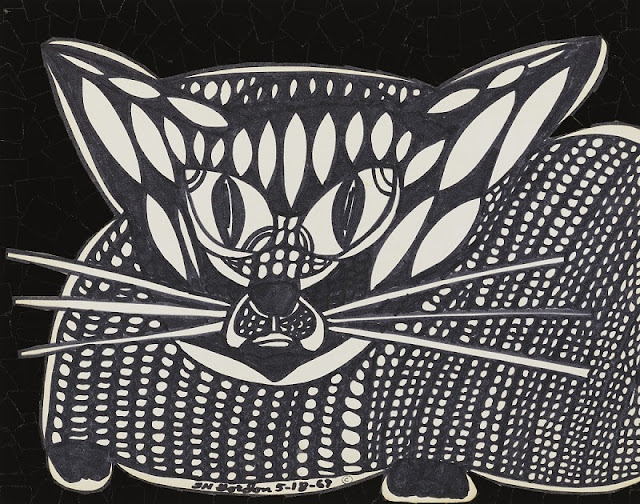 |
| 1969 Cat by Ted Gordon 1924-) felt-tipped pen and ink and collage on paperboard 29.4 x 37.1 cm Smithsonian American Art Museum |
Harold Theodore Gordon was born in Louisville, Kentucky, as the eldest son in a Jewish family. Abandoned by his mother, who seems not to have been able to look after her child, he was brought up by his paternal grandparents. Following the death of his father in 1939, Gordon moved with his grandparents to Brooklyn, New York, where he began his university studies. However, he dropped out and took a series of temporary jobs while at the same time beginning to draw - first on a restaurant's napkins, then on pieces of cardboard at home. In 1951 he moved to San Francisco, married, and took up his studies again, which he completed in 1958. He then took an administrative job in the city council, which he held for twenty-five years.
Avoiding all social relations and keeping contact with the outside world to a minimum, Gordon pursued his creative ambitions, which he called "image-making", discretely. His compositions are characterised by a compulsive need to fill in his figures with ballpoint pen, felt-tip pen, and coloured pencil. From 1967 his drawings began increasingly to take the human form and, later, made faces their subject. These are all in fact self-portraits, in which he explores every aspect of facial expression.
 |
| 1969 The Rattle Cat by Alexander Calder (1898-1976) sheet metal and paint 20.3 x 86.3 x 17.8 cm Private Collection |
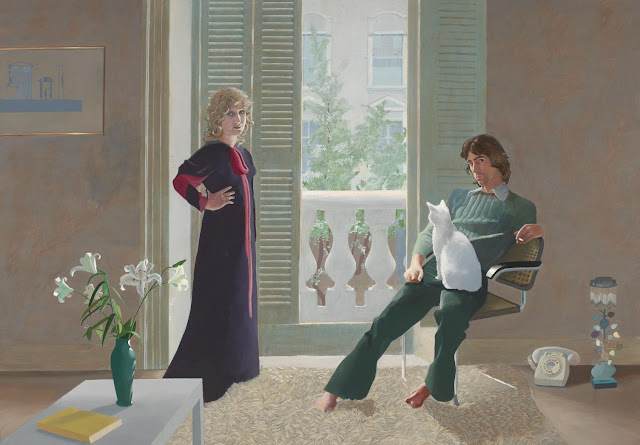 |
| 1970-71 Mr. and Mrs. Clark and Percy by David Hockney (1937-) acrylic on canvas 214 x 305 cm Tate, London |
David Hockney studied at Bradford School of Art from 1953 to 1957 and the Royal College of Art from 1959 until 1962. He was awarded the Royal College of Art gold medal in 1962 in recognition of his mastery as a draughtsman and his innovative paintings. His early work was stylistically diverse, combining graffiti-like images with quotations from the poetry of Walt Whitman.
Hockney moved to Los Angeles in 1963. He produced highly evocative, sometimes homoerotic, iconic images of urban life. By the late 1960s his work had become more naturalistic but it was always characterised by Hockney’s alertness to the psychological and emotional resonance of his subject matter. Hockney’s work also includes landscapes, photography, printmaking and stage designs for the Royal Opera House, Covent Garden, the Metropolitan Opera, San Francisco Opera and the Los Angeles Music Centre Opera
In 1972 work Portrait of an Artist (Pool with Two Figures) sold at Christie's auction house in New York City for $90 million (£70 million), becoming the most expensive artwork by a living artist sold at auction. This broke the previous record, set by the 2013 sale of Jeff Koons' Balloon Dog (Orange) for $58.4 million. Hockney held this record until 2019, when it was broken by an artwork by Jeff Koons.
 |
| c1970 Cat calling Kittens by Tomoo Inagaki (1902-1980) colour woodblock print |
 |
| c1970 White Cat and Black Cat by Tomoo Inagaki (1902-1980) colour woodblock print 42.4 x 32 cm The British Museum, London |
 1971 Cat at Fireplace by Tomoo Inagaki (1902-1980) colour woodblock print |
| 1971 Long-tailed Cat by Tomoo Inagaki (1902-1980) colour woodblock print |
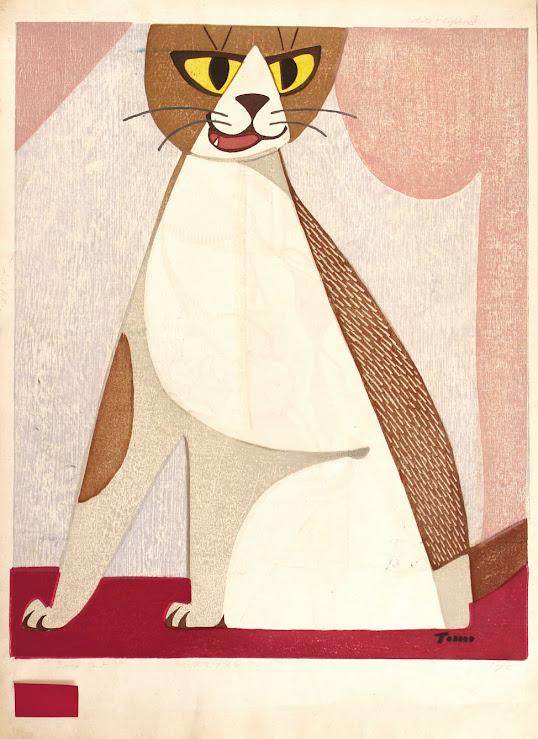 |
| 1972 Boss Cat by Tomoo Inagaki (1902-1980) colour woodblock print |
 |
| 1972 Cats at Dawn by Tomoo Inagaki (1902-1980) colour woodblock print |
 |
| 1974 Leisure Day by Togyu Okumura (1889-1990) watercolour The National Museum of Modern Art, Tokyo |
Togyu Okumura was born in 1889. He was a famous Japanese modern painter of the Nihonga style of watercolour painting. His original name was Yoshizō - the name Togyu referred to a poem from his father who ran a publishing business.
Okumura is characterised by his works which achieve unusual, exquisite quality of colours through the application of the white gofun pigment 100 or 200 times as foundation. Okumura died in 1990.
 |
| before 1978 A Siamese Cat stalking a Butterfly by Charles F. Tunnicliffe (1901-1978) watercolour on paper 17.7 x 25.6 cm |
Charles Frederick Tunnicliffe, born in 1901, was an internationally renowned naturalistic painter of British birds and other wildlife. He spent most of his working life on the Isle of Anglesey. He is popularly known for his illustrations for the novel Tarka the Otter.
in 1916 he began to study at the Macclesfield School of Art. He went on to win a scholarship to the Royal College of Art in London. Tunnicliffe worked in several media, including watercolour, etching and aquatint, wood engraving, scraperboard, and oil painting.
 |
| before 1978 Autumn Kitten by Charles F. Tunnicliffe (1901-1978) pencil and watercolour 42.5 x 59 cm |
 |
| before 1978 Stalking Siamese Cat by Charles F. Tunnicliffe (1901-1978) |
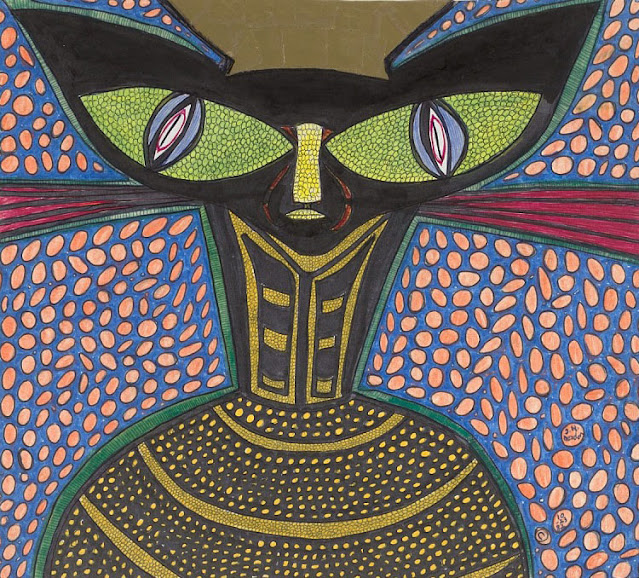 |
| 1982 Untitled (Cat) by Ted Gordon (1924-) ballpoint pen and ink, felt-tipped pen and ink, crayon 27.3 x 30.5 cm Smithsonian American Art Museum |
 |
| 1997 Hino Moto no Keko by Tadanori Yokoo (1936-) |
Born 1936 in Nishiwaki, Hyogo Prefecture, Japan. Tadanori Yokoo is one of Japan’s most well-known artists, who began working with painting in 1966. In parallel, Yokoo’s early screenprints combined photographs with the influence of traditional Japanese ukiyo-e (woodblock prints) and pop art’s flat colours and overtly sexual content. Awarded the Grand Prize for Prints at the 6th Paris Youth Biennale in 1969, Yokoo experimented with collage and illustration, re-appropriating found photographs and images, which reflected on the rapid changes and Westernisation of Japan post-war society. His work became influenced by mysticism following his trip to India in the 1970s, resulting in posters with eclectic imagery sharing the aesthetics of the underground psychedelic magazines of the time.
 |
| before 1980 Black Cat by Tomoo Inagaki (1902-1980) colour woodblock print |
 |
| before 1980 Cat in Bush by Tomoo Inagaki (1902-1980) colour woodblock print |
 |
| before 1980 Four Cats by Tomoo Inagaki (1902-1980) colour woodblock print |

No comments:
Post a Comment
Note: only a member of this blog may post a comment.